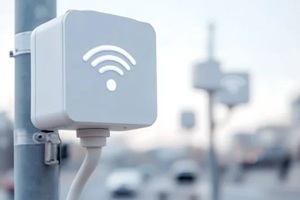 The Internet of Things (IoT) ecosystem is growing in complexity and utility, offering businesses expanded cloud capabilities and device integration. An IoT gateway acts as a bridge between these devices and the cloud server, which means it plays a central role in helping modern organizations secure, streamline, and manage the data flow within their connected device environment.
The Internet of Things (IoT) ecosystem is growing in complexity and utility, offering businesses expanded cloud capabilities and device integration. An IoT gateway acts as a bridge between these devices and the cloud server, which means it plays a central role in helping modern organizations secure, streamline, and manage the data flow within their connected device environment.
This article details the purpose and benefits of IoT gateways, including the challenges that organizations face in deploying them effectively in modern cloud environments.
What Is An IoT Gateway?
Most IoT devices, such as temperature sensors and manufacturing asset trackers, lack processing power, storage, and security resources compared to other devices that interact with corporate cloud architecture. This commonly leads to bottlenecks and security concerns, compounded by the sheer number of devices that many organizations need.
What Are The Key Functions Of IoT Gateways?
A resource-constrained device, such as an IoT sensor, lacks the processing power and security architecture needed to interact with cloud systems.
An IoT gateway serves organizations by taking over these functions for the network, removing the need for more complex devices while solving many network pain points that organizations deal with.
To achieve this, IoT gateways serve five core functions:
1. Translating Protocols
IoT gateways improve compatibility between devices by normalizing payloads to match back-end ingestion, even on proprietary protocols. This eliminates data flow bottlenecks resulting from compatibility issues between IoT devices and the cloud infrastructure.
2. Maintaining Connections
IoT gateways can convert data between devices on different networks, such as cellular, Wi-Fi, ethernet, and Bluetooth, when devices using these protocols need to exchange data in real time. Gateways facilitate network operations even when one channel fails or a device only needs to connect and transmit data periodically. Notably, the gateway must support multiple network interfaces and pair them to establish these inter-network conversions.
3. Preprocessing Raw Data
With IoT gateways, businesses can filter or compress raw data before transmitting it. Edge computing allows local computations such as data aggregation and anomaly detection to reduce the amount of data that needs to be transmitted, which improves network response time by conserving valuable bandwidth for more essential tasks.
4. Securing Transmissions

Gateways serve as controlled access points, regulating and securing the exchange of data between external networks and an organization’s internal infrastructure. They can host TLS, VPNs, local IDS/IPS modules, or firewalls, depending on their capabilities, to help protect IoT data streams and prevent unauthorized access.
Gateways may also support temporary local data caching when networks go offline, such as during a storm, infrastructure change, or security breach. They can then forward this data once connectivity is restored.
5. Managing Devices
Through centralized controls, organizations can manage connected devices with configuration updates, system health monitoring, software and firmware upgrades, and remote provisioning. With these functions, gateways help make the organization more scalable and efficient while maintaining security.
Without these processes, businesses with hundreds or thousands of IoT devices, such as those in manufacturing or agriculture, open themselves to an unsustainable risk exposure due to their network’s complexity. Hackers could intercept data transmissions or enter the system through outdated firmware. Gateways aid in processing sensor data while caching, translating, and securing the transmissions to help keep beneficial IoT device networks sustainable.
Example Use Cases For IoT Gateways
These core functions benefit businesses of any size, but those with expanding IoT device networks require gateways to transmit data securely and meet compliance regulations. Here are several industry examples of IoT gateways contributing to organizational efficiency:
- Smart manufacturers can use IoT gateways to aggregate data from their current industrial controllers and transmit it to new ERP systems
- Healthcare practices need gateways to handle and log upstream encrypted data to comply with HIPAA data privacy requirements for medical devices, such as wearables
- Utility companies can use gateways to connect their network of grid sensors and smart meters and relay the data to their control center
- Agricultural organizations can securely collect data from geographically dispersed sensors and route it to a central hub for real-time localized decision-making, such as for irrigation or fertilization processes
Gateways provide these and other organizations with clear benefits, though they also introduce complex challenges related to hardware compatibility, software management, and data security. Experienced wireless network providers help businesses establish or scale IoT networks in any industry.
Contact Allpoint Wireless To Establish Effective IoT Gateways In Your Business
![]() IoT gateways handle core features such as protocol translation, device control, and security in one unified layer. Manufacturers, healthcare practices, and agricultural organizations present clear use cases for secure gateways due to the size of their device networks. However, any business establishing or scaling its IoT usage should also establish and maintain IoT gateways.
IoT gateways handle core features such as protocol translation, device control, and security in one unified layer. Manufacturers, healthcare practices, and agricultural organizations present clear use cases for secure gateways due to the size of their device networks. However, any business establishing or scaling its IoT usage should also establish and maintain IoT gateways.
Contact our team at Allpoint Wireless to learn how IoT gateways will function in your organization, including deployment considerations, and how our team can help personalize the network for your business’s current needs as well as your plans for expansion.